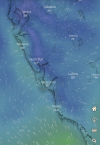I live in florida. It's rainy season now. So, we have sudden squalls and high winds preceding them. Where I was, the air was calm, but the sky didn't look too pretty. Lots of splotchy black clouds. The air was a mix of cold and hot. Not a good sign, but I took off anyway. So, I take off, and fly north. Suddenly, I'm going 46 mile per hour indicating a strong tail wind! Then I get a high wind warning. I stop the drone and turn back home. The drone would only go between 2 and 10mph. Luckily , I hadn't gone very far and I had over 80 % battery. The wind and trees around me were still calm, but in florida, the weather across the street can be totally different than that on the other side. I stayed calm, because I knew I had plenty of power and time. I made it back with 60 percent battery, but at times the drone actually got stuck at 0 mph. I kept lowering altitude, when I got to 30ft I was ok, but still only moving at 6-12mph, and now I had to contend with trees and power lines. I flew the drone manually the whole time back, I no longer trust the automated tech much. I landed it in calm winds on my balcony, but the drone was all wet. I apparently hit a squall. Didn't see that coming. It was tiny, but almost took my drone with it. It was a pain in the a** getting home though. I finally got back up to 25mph when just a few blocks away. Another day of drone fun in Florida rainy season.
EDIT: Just so everyone is on the same page:
The term "SQUALL" is used to refer to a sudden wind-speed increase lasting MINUTES. In 1962 the World Meteorological Organization (WMO) defined that to be classified as a "squall", the wind must increase at least 8 m/s and must attain a top speed of at least 11 m/s, lasting AT LEAST ONE MINUTE IN DURATION.
EDIT: Just so everyone is on the same page:
The term "SQUALL" is used to refer to a sudden wind-speed increase lasting MINUTES. In 1962 the World Meteorological Organization (WMO) defined that to be classified as a "squall", the wind must increase at least 8 m/s and must attain a top speed of at least 11 m/s, lasting AT LEAST ONE MINUTE IN DURATION.
Last edited:











